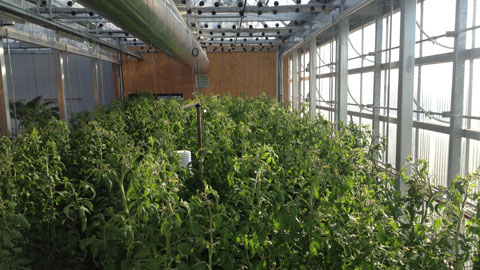ICTA-UAB thesis quantifies the great potential of urban agriculture

08/09/2015
Urban rooftop agriculture has great potential for increasing local production and consumption of foodstuffs, at a lower cost and with less environmental impact than products from other areas, like Almería. This is one of the conclusions of the doctoral thesis "Sustainability assessment of urban rooftop farming using an interdisciplinary approach" by ICTA (Institute for Environmental Science and Technology) researcher Esther Sanyé-Mengual, in which she evaluates the implementation and sustainability profile of the different forms of urban rooftop agriculture, and the different crops and techniques involved. The study highlights the advantages of using shopping-centre rooftops for this groundbreaking activity due to their architectural characteristics, but also shows the possibilities that the extensive rooftops of industrial zones open up for implementing it on a large scale.
Urban agriculture is proliferating in city areas in response to the rise in urban population, increasing awareness of the environmental implications of industrial food production, and the need to address social problems. These new systems of local production allow sustainable models to be developed that re-establish ties between producers and consumers, boost local economies and reduce the transport of foodstuffs. In addition, the economic crisis has led to an increase in the number of abandoned city buildings where urban agriculture projects have arisen, whether on a commercial basis or self-managed by private individuals or communities. These new urban farmers have found on the city's rooftops a space on which to establish plots, greenhouses and gardens to grow food, giving rise to what is known as "urban rooftop agriculture". This phenomenon, however, has not yet been evaluated in detail.
This thesis starts from the analysis of three case studies to deal with two questions. What is the potential of urban rooftop agriculture in qualitative and quantitative terms? And what are the environmental impacts and the financial costs of the different forms of urban rooftop agriculture? Within an interdisciplinary framework, Sanyé-Mengual examines issues like the perceptions of the different social actors involved in urban agriculture and rooftop agriculture, identifies available rooftops that are viable for this activity using Geographical Information Systems (GIS), and quantifies the environmental loads and the financial costs of different types of rooftop agriculture using life-cycle assessment.
Although not all social actors support rooftop agriculture they all acknowledge its sustainable benefits (environmental, economic and social) in the context of developing a green local economy. The study shows the great potential of this activity for increasing local food production and reducing the environmental impact of food transport in the town.
To determine which roofs are technically and economically viable for this use, variables like the following were assessed: available space (a minimum of 500 square metres), sunlight, robustness, sloping and planning regulations. Shopping centres showed greater potential in the short term (over 50% currently useable) than industrial zones (8%) as their robust architecture is more suitable for installing greenhouses. Nevertheless, industrial rooftops are much bigger and could be used on a large scale in the long term. In fact, the study concludes that this 8% of rooftops in the Zona Franca district is enough to supply 10% of the Barcelona population with tomatoes.
Just like in conventional agriculture it is the structure of the greenhouse itself that generates the greatest economic and environmental impact. Tomato production, however, has less environmental impact than conventional greenhouses not only on completing production but also on reaching the consumer. Regarding financial costs, although tomato production is 21% more expensive if done on rooftops, if the whole conventional supply chain is taken into account (packaging, transport, etc.) it turns out to be 21% cheaper.
On the question of rooftop gardens, the study concludes that these are usually created with recycled materials like pallets, but the resources for cultivation (water, fertiliser, energy) have a highly significant environmental impact. A greater eco-efficiency of soil-based production becomes apparent. Growing fruit such as tomatoes has a lower environmental impact and better economic results than leaf vegetables like lettuce, since productivity is higher. The tendency is to resort to polycultivation of different fruits and vegetables with a homogenous design, limiting the efficiency of leaf vegetables with a lower planting density and a greater resource consumption. For this reason, the author suggests there is a need to divide the gardens by crop type to balance out these differences.
This thesis helps to understand how urban agriculture and urban rooftop agriculture can develop to become competitive and sustainable, and aims to inform decision-taking on design and development.